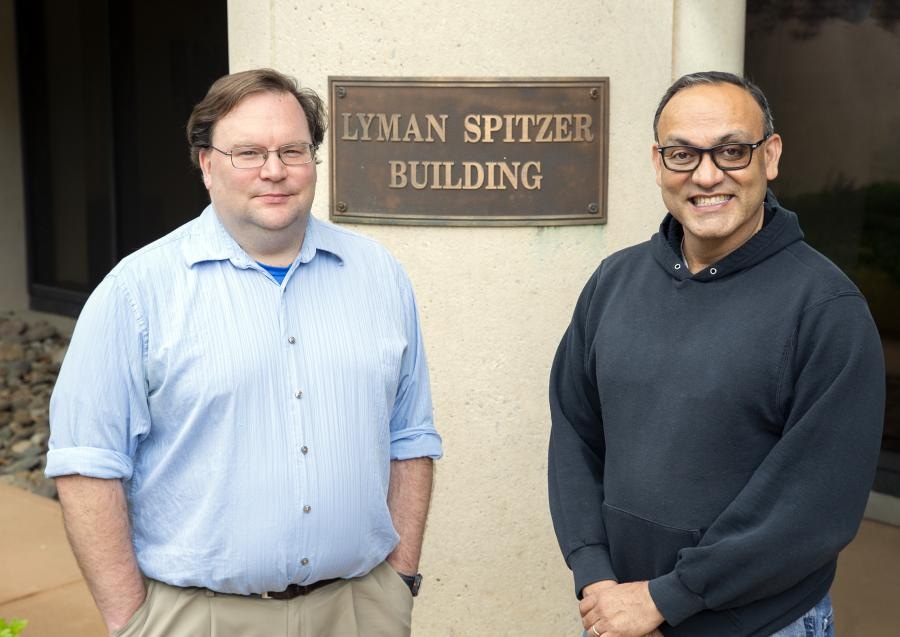Jul 3 2019
Beryllium, a hard, silvery metal has been used for years in spacecraft and X-ray machines. Of late, the metal has a new role in the pursuit of extracting the power that drives the stars and sun to Earth. Beryllium is one of the two key materials used for the wall in ITER, a multinational fusion facility under construction in France to show the feasibility of fusion power.
 PPPL physicists Robert Lunsford, left, and Rajesh Maingi, right. (Photo credit: Elle Starkman)
PPPL physicists Robert Lunsford, left, and Rajesh Maingi, right. (Photo credit: Elle Starkman)
Physicists from the U.S. Department of Energy’s (DOE) Princeton Plasma Physics Laboratory (PPPL) and General Atomics have recently determined that injecting minute beryllium pellets into ITER could help in stabilizing the plasma that fuels fusion reactions.
Experiments and computer simulations revealed that the injected granules help form conditions in the plasma that could activate small eruptions known as edge-localized modes (ELMs). If activated often enough, the tiny ELMs prevent huge eruptions that could stop fusion reactions and damage the ITER facility.
Researchers are aiming to globally imitate fusion on Earth for a nearly inexhaustible supply of power to produce electricity. The process requires plasma, a piping hot soup of free-floating electrons and atomic nuclei, or ions. The integration of the nuclei discharges an incredible amount of energy.
In the current experiments, the scientists injected granules of lithium, carbon, and boron carbide — light metals that possess quite a few properties of beryllium — into the DIII-D National Fusion Facility that General Atomics manages for the DOE in San Diego. “These light metals are materials commonly used inside DIII-D and share several properties with beryllium,” said PPPL physicist Robert Lunsford, lead author of the paper that reports the results in Nuclear Materials and Energy.
Since the internal structure of the three metals is akin to that of beryllium, the researchers deduce that all of these elements will impact ITER plasma in similar ways. The researchers also used magnetic fields to make the DIII-D plasma look like the plasma as it is expected to occur in ITER.
These were first-of-its-kind experiments.
This is the first attempt to try to figure out how these impurity pellets would penetrate into ITER and whether you would make enough of a change in temperature, density, and pressure to trigger an ELM. And it does look in fact like this granule injection technique with these elements would be helpful.
Rajesh Maingi, Study Co-Author and Head of Plasma-Edge Research, PPPL
If so, the injection could minimize the hazard of large ELMs in ITER. “The amount of energy being driven into the ITER first walls by spontaneously occurring ELMs is enough to cause severe damage to the walls,” Lunsford said. “If nothing were done, you would have an unacceptably short component lifetime, possibly requiring the replacement of parts every couple of months.”
A program written by Lunsford himself revealed that injecting beryllium granules measuring 1.5 mm in diameter, about the thickness of a toothpick, would pierce into the edge of the ITER plasma in a way that could activate small ELMs. At that size, an adequate amount of the surface of the granule would evaporate, or ablate, to permit the beryllium to enter to locations in the plasma where ELMs can most successfully be activated.
The following step will be to calculate whether density variations caused by the impurity pellets in ITER would really activate an ELM as the experiments and simulations show. This study is currently in progress in partnership with international specialists at ITER.
The scientists imagine the injection of beryllium granules as merely one of many tools, including employing external magnets and injecting deuterium pellets, to manage the plasma in doughnut-shaped tokamak facilities like ITER.
The researchers hope to carry out similar experiments on the Joint European Torus (JET) in the UK, presently the world’s largest tokamak, to verify the results of their calculations. Says Lunsford, “We think that it’s going to take everyone working together with a bunch of different techniques to really get the ELM problem under control.”
The DOE’s Office of Science supported this research.